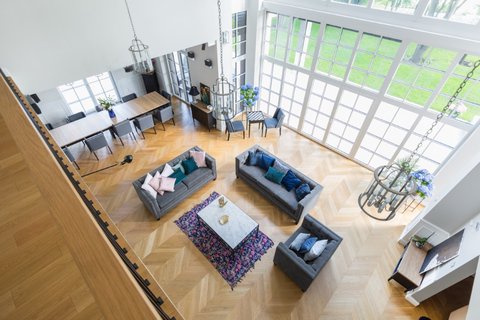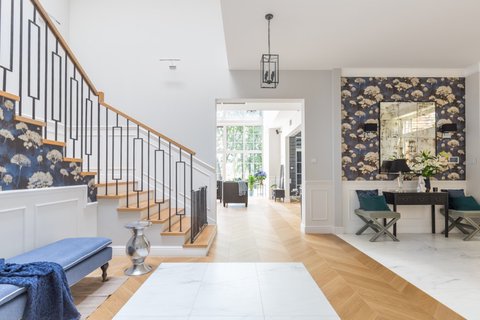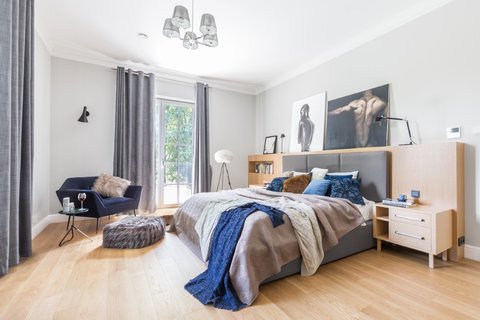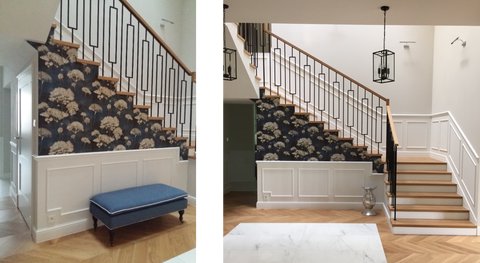New Modern Style House

Concept
We began working on the interiors of this large three-story house with an original brick-clad facade and large windows at the stage of an open-shell construction.
My design work also included an advisory role in selecting windows, determining the division of muntins, and choosing the color of the clinker on the facade. This allowed me to influence how the windows would appear from the inside and to immerse myself in the home’s character early in the process.
Increasingly, I begin working on home interiors during the construction phase, sometimes even at the architectural design stage. This approach is highly beneficial because it gives us time to prepare guidelines for installers and builders based on a refined concept and an approved functional layout.

Additionally, this is the time to discuss issues such as plumbing stacks, chimneys, and beams with the architect, which later play a key role in interior design. The architect prepares the spatial layout according to the client’s specifications but, understandably, does not focus on interior arrangement and furnishings. While working on the concept, there are opportunities to modify the architecture so that interior spaces are perfectly aligned with the planned arrangement and decor. Sometimes, a small shift in a chimney, a recessed wall niche, or repositioning plumbing connections can make a significant difference. However, if the building is already constructed, we must adapt to existing constraints.

The concept of this house was quickly accepted, and the biggest challenges turned out to be choosing a practical flooring solution and determining the shape of the kitchen island.

What fascinates me most is how each client prioritizes entirely different aspects of a project. I am prepared for this and understand that sometimes a single key element of the interior can determine a homeowner’s satisfaction.
The work on the island’s shape lasted several weeks, resulting in multiple design versions. The final choice was a compromise between the client’s irregular shape preference and my vision of a long, straight island with space for cooking and seating.

As the project progressed, compromise became the foundation of our collaboration. I always strive to understand my clients’ motivations, thought processes, and expectations, so I willingly concede in cases where their choice ensures their comfort, even if it differs from my preference.
In this home, compromises involved:
- The shape of the kitchen island,
- The size of the sofas in the living room,
- The clients’ decision to forgo glass partitions between the living room and the TV room, as well as between the living room and the hallway,
- The line of window decorations in the bedroom,
- The use of artwork within the large living area,
- Choosing a large rug instead of a smaller one that wouldn’t extend under the furniture.

Despite these compromises, I find the final result highly satisfying. Given the residents’ positive reception of the interiors, I believe my work was successfully completed.

Materials
Material selection for this home focused on choosing flooring and its layout in a way that ensured durability when accessing the garden and garage, while maintaining full user comfort. We aimed for elegant and timeless solutions, keeping costs in mind.

We opted for marble-patterned tiles and pastel designs in children’s areas.


I managed to convince the clients to use unique onyx tiles in the guest bathroom, which became my favorite of all six bathrooms in the house.


Wallpapers were also a crucial design element. More on this in the summary.

Execution Guidelines

Despite having a detailed execution folder, I conveyed many instructions to the team on-site. Since various workers performed independent tasks, and there was no general contractor overseeing the process, coordination was challenging.

Working with onyx and marble tiles was particularly interesting, as their patterns did not always look harmonious when randomly arranged. The entire floor and walls of the guest bathroom were laid out “dry” in the workshop, with each tile numbered and assigned a specific location.

A similar approach was taken with the herringbone tile arrangement, ensuring that diagonal gray streaks blended aesthetically. Molding around the stairs, windows, and at unusual heights in the living room was also pre-drawn on walls to prevent errors and misinterpretations.

The interior color scheme, based on whites softened with grays and complemented by navy blues and blue-grays, guided the selection of tiles, wallpapers, and woodwork colors. Warm wood tones provided a counterbalance to the cool wall colors.

Furniture and Lighting
The clients’ approach to furnishing was unique, relying on sales, special offers, and promotional deals. While decisions were made based on predefined guidelines, this method did not always allow for careful, deliberate ordering.

Summary
What Surprised Me
- The wooden countertop in the kitchen did not work well for these clients. Despite extensive discussions about wood’s characteristics and maintenance, communication seemed to have fallen short. As a result, the owners now invest significant effort in keeping the countertops pristine.

- The final window decor did not align with my plans. The client made independent adjustments, leading to a mixed implementation of my recommendations. I regret that this aspect was handled in such a way, as the final effect could have been much more refined.

Positive Surprises
- Choosing bold floral wallpaper was an unexpected yet excellent decision, adding character and timeless beauty to the home.


- The bathrooms for the two daughters turned out exceptionally well, despite minimal focus during planning.




Publication
Photos from this project were featured in the July-August 2019 issue of “Świat Rezydencji.”